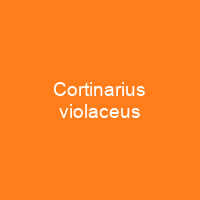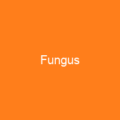
Cortinarius violaceus: The Purple Enigma of the Forest
Imagine a forest where nature’s palette is at its most vibrant, and among these colorful wonders lies Cortinarius violaceus. This fungus, with its dark purple mushrooms, stands out like a jewel in the crown of the Northern Hemisphere’s forests. But what makes this species so intriguing? Is it just its striking appearance, or does it hold secrets that scientists are still unraveling?
A Historical Journey
First described by Carl Linnaeus way back in 1753, Cortinarius violaceus has a rich history. Its name has changed over time, reflecting the evolving understanding of mycology. From Agaricus violaceus to Cortinarius violaceus (L.: Fr.) Gray in 1821, the species has undergone several transformations. But why did its name change? Was it just for the sake of taxonomy, or was there something more significant about this fungus that warranted a new identity?
Ecological Relations and Distribution
The fungus forms symbiotic relationships with plant roots, making it an essential part of the forest ecosystem. It is predominantly found in conifer forests in North America and deciduous forests in Europe. But why does it prefer these environments? Is there something unique about the soil or the trees that make them ideal for this species to thrive?
Distinctive Features
Cortinarius violaceus is not just a pretty face; its features are as distinctive as they are fascinating. Its convex cap, dark violet to blue-black in color, and fine downy scales on the pileipellis layer make it stand out among other fungi. The stipe, with its wool-like fibrils and purple mycelium, adds another layer of complexity to this species. But what makes these features so important? Are they just for show, or do they play a crucial role in the fungus’s survival?
Genetic Insights
A 2015 genetic study revealed that C. violaceus diverged from its closest relative around 3.9 million years ago, suggesting recent dispersal across large bodies of water. This finding challenges our understanding of how fungi spread and adapt to new environments. But what does this mean for the future of Cortinarius violaceus? Are we witnessing a species that is evolving right before our eyes?
Edibility and Toxicity
Though sometimes considered edible, its appearance is more distinctive than its taste. The species is readily distinguished from other Cortinarius species by its dark coloration and distinct cystidia. But why does it have such a unique appearance? Is there an evolutionary reason behind this, or is it just a coincidence?
Ecological Role
Cortinarius violaceus plays a vital role in the forest ecosystem by forming mycorrhizal associations with various tree species. In North America, it favors conifers and is relatively common in old growth forests in the Pacific Northwest. But what does this mean for the health of these forests? Are we witnessing the impact of human activities on the natural balance of ecosystems?
Conservation Status
Cortinarius violaceus is found across North America, Europe, and Asia but is rare in Europe and listed as endangered in the British Isles. It occurs in subarctic areas of western Greenland but not Iceland. But why is it so rare in some regions? Is there a threat to its survival that we are yet to understand?
Conclusion
Cortinarius violaceus, with its dark purple mushrooms and distinctive features, continues to captivate scientists and nature enthusiasts alike. From its historical journey to its ecological role, this species holds many secrets waiting to be uncovered. As we continue to study it, we must also consider the conservation of these unique fungi in our forests. After all, every species plays a crucial part in maintaining the balance of life on Earth.
You want to know more about Cortinarius violaceus?
This page is based on the article Cortinarius violaceus published in Wikipedia (retrieved on November 25, 2024) and was automatically summarized using artificial intelligence.







